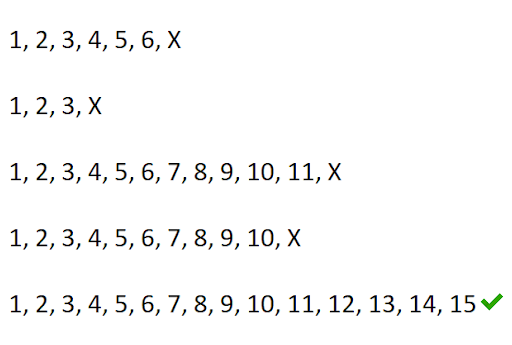If you’re preparing for the GMAT to apply to MBA programs, you may want to know how to ace the GMAT. Or you may be wondering what’s the best way to increase your score on a section of the GMAT or break out of a score plateau. GMAT aspirants ask me about these things constantly, and I have a number of answers, including what I say in these posts on how to score 705+ on the GMAT and how to prepare for GMAT Verbal.
At the same time, one thing I recommend to almost everyone who asks about effective GMAT preparation is the streaks method of practicing for the GMAT. The reason is that the streaks method is super effective for mastering GMAT topics and the GMAT in general. In fact, I’ve seen the streaks method be a GMAT prep game changer for student after student. So, in this post, I’m going to discuss why the streaks method is so effective and how you can use it to achieve your GMAT goal.
Here are the topics we'll cover:
Let’s begin by discussing some common challenges people experience in preparing for the GMAT.
Common GMAT Prep Challenges
People preparing for the GMAT often find that their prep gets them only so far. They learn concepts and strategies and practice a lot, but don’t see the results they want. Often, they feel pretty good about their knowledge but don’t see their work translating into high practice test scores or feel confident on test day. Others simply wish their preparation were moving them ahead faster.
So, why do these outcomes occur?
A common reason why MBA applicants aren’t satisfied with the results of their GMAT prep is that, unknown to them, they aren’t developing all the skills they need. Another is that there are lingering undiscovered gaps in their GMAT knowledge.
KEY FACT:
People preparing for the GMAT often have trouble getting the results they want because of knowledge and skill gaps they aren’t aware they have.
Much of what underlies these issues and others is the way people practice for the GMAT. Let’s discuss why.
Issues With Common GMAT Practice Approaches
One common issue with people’s GMAT study plans is that they do all their practice timed. Knowing that they’ll have around two minutes to answer each question when taking the GMAT, they solve questions in around two minutes when practicing as well. The problem with that approach is that, in doing all practice timed, people don’t give themselves time to learn.
Another issue is that people shoot for “getting most questions correct.” Getting 80 percent or even 70 percent of practice questions correct may seem pretty good. However, it may not get you to your GMAT target score. Here’s why.
If you’re preparing for a test of knowledge and you know 70 to 80 percent of the knowledge you may be tested on, you can be pretty confident that you’ll pass. The GMAT isn’t a test of knowledge though. The GMAT tests skill. So, here’s something to think about.
You can get 80 percent of GMAT practice questions correct by getting 3 correct, then 1 wrong, then 5 correct, then another 1 wrong. So, if you get 70 to 80 percent of questions correct, you’re actually missing questions pretty often. What does that performance indicate about your skills? Are you highly skilled and under control? Not really.
And in Verbal and Data Insights, this issue is especially pronounced. After all, you can get 50 percent of Verbal questions and many DI questions correct by eliminating three choices and guessing between the last two. Accordingly, you can get 70 to 80 percent of GMAT Verbal questions correct even if, much of the time, you’re not completely clear about what’s going on in the questions.
KEY FACT:
Doing timed practice with a goal of “getting most questions correct” often does not result in mastery of GMAT topics.
So, what’s the solution?
The Streaks Method - A GMAT Prep Game Changer
The solution to many of these issues is to practice in a different way. Rather than shoot for certain accuracies, you can shoot for streaks of questions answered correctly in a row.
For example, let’s say that, instead of typically getting 80 percent of questions in a topic correct, you could typically get 15 questions in the topic correct in row. In that case, you wouldn’t be crashing every few questions and feeling out of control. Rather, you’d know you’re in control because you could reliably get questions correct in long streaks without any errors.
So, the gist of the streaks method is that it involves developing the knowledge and skills you need to achieve a high score on the GMAT by shooting for streaks of correct answers.
KEY FACT: The idea underlying the streaks method is that, if you can get many questions in a topic correct in a row, you’ve likely mastered that topic.
Let’s now discuss in more detail how the streaks method works.
How to Use the Streaks Method to Master the GMAT
We’ve seen that the streaks method involves mastering GMAT topics by shooting for streaks of correct answers in a row. Now, here’s how to go about shooting for those streaks, using an approach developed by my friend Dan Cummins.
The first step is to decide on a GMAT topic to practice. You can choose a narrow topic, such as Absolute Value questions. Alternatively, you could choose a broader topic, such as Problem Solving or Reading Comprehension questions. Of course, you’ll then need a source of practice questions involving that topic such as the Official Guide ebook or an online question bank.
Then, the idea is that you practice that topic until you’ve achieved streaks of certain lengths for easy, medium, and hard questions. Typical streak length goals are 15 easy, 15 medium, and 10 hard questions.
So, having chosen a topic, you’d first start answering easy questions, one at a time. Each time you get an easy question correct, you add that question to your streak. For example, if you were to get 3 questions correct in a row, you’d have achieved a streak of 3, and to extend that streak to 15, you’d have to get 12 more correct in a row.
If you miss a question before you achieve your streak, you need to start over again at 0. For example, if you were to get 6 correct in a row and miss the 7th question, you wouldn’t continue the streak. Rather, you’d start a new streak, starting the count at 0 and adding to it as you got questions correct.
PRO TIP:
To use the streaks method, choose a topic you want to master, and then practice that topic until you’ve achieved streaks of correctly answered easy, medium, and hard questions in that topic.
How the Progress of Achieving a Streak Goes
Here’s an example of how achieving a streak of questions in a topic at a particular difficulty level can go. Each line of numbers is a streak attempt, with the X at the end of a line representing a missed question that broke the streak.

We can see that, in this case, it would have taken answering 7 + 4 + 12 + 11 + 15 = 49 questions to achieve a streak of 15 correct in a row. Sometimes, you’ll get your target streak in a few attempts. Other times, it may take many attempts to achieve it.
PRO TIP:
When using the streaks method, don’t continue a set of questions after you miss one and consider that set a streak. Rather, when you miss a question, start a new streak at 0 and count from there.
Mastering a Topic Using the Streaks Method
Continuing our example, you’d first achieve a streak of 15 easy questions, going through a process like the one illustrated above. Then, you’d move on to medium questions and do the same thing. Finally, you’d achieve a streak of hard questions, perhaps 10 or 15 questions long, with the length depending on your GMAT target score.
To achieve your streaks, any time you break a streak, you analyze the question that broke your streak and determine what you need to do so that you don’t break your streak in the same way again.
For example, if you were shooting for a streak of 15 medium Weaken Critical Reasoning questions and the 8th question broke your streak, you’d determine why. You might find that you missed the question because you didn’t identify the conclusion exactly. Then, you’d start a new streak and be careful to identify the conclusions exactly so that you didn’t break your streak that way again.
Alternatively, you might find that there’s something involved in answering a question that you don’t understand. For instance, there could be a concept that you hadn’t learned. In that case, you would learn about that concept so that you wouldn’t break a streak again because of your not understanding that concept.
Of course, the great thing is that, by the time you achieve easy, medium, and hard streaks in a topic, you’ll generally be pretty sure that you’ve mastered the topic. Imagine how confident you’ll be on test day if you’ve achieved easy, medium, and hard streaks in every GMAT Quant, Verbal, and Data Insights topic.
PRO TIP:
For best results, whenever you break a streak, seek to identify and address the issue that caused you to break your streak so that it doesn’t cause you to break a streak again.
How Long Should My Streaks Be?
A good starting rule of thumb is that, to achieve a 90th percentile or higher GMAT score, you should shoot for streaks of at least 15 easy, 15 medium, and 10 hard questions in a row. If your goal is lower, then shorter streaks will work, such as 15 easy, 10 medium, and 5 hard. For a higher score, you should shoot for longer streaks, such as 20, 20, and 15 for a 98th percentile score.
PRO TIP: Typical target streak lengths are 15 easy, 15 medium, and 10 hard for a 90th percentile score.
What About Speed and Timing?
When you’re shooting for streaks, it’s best to allow yourself all the time you need to achieve the streaks. In other words, achieving the streaks is your first priority, and how fast you answer the questions isn’t as important. So, you’ll generally do streaks method practice untimed.
At the same time, even though you’re doing the questions untimed, using the streaks method to master topics will make you faster. After all, the same skills that support accuracy support speed. For example, understanding exactly what’s going on in questions or reading answer choices thoroughly will make you not only accurate but also fast.
PRO TIP:
Developing your skills through doing untimed streaks method practice will make you both more accurate and faster.
Now that you know how to practice using the streaks method, let’s get even more excited to use it by considering some of the benefits.
The Benefits of Using the Streaks Method to Prepare for the GMAT
The main benefit of using the streaks method is that, in the process of achieving streaks, you develop a set of skills that you may not even have been aware you lacked. There are many different aspects of getting questions correct consistently. Among them are making sure you understand the question, reading answer choices correctly, keeping facts straight, and performing calculations accurately. In the process of achieving streaks, you develop skill in all these aspects.
Another benefit of using the streaks method is that it gets you focused on the right thing, which is whatever you need to learn to get questions correct consistently. If you’re shooting for accuracy, even relatively high accuracy, it’s easy to let slide whatever causes you to miss some practice questions. In contrast, when shooting for streaks, you’re going to notice any knowledge gap or execution issue that causes you to break your streak, and you’re going to address it so that it doesn’t break your streak again.
In addition, by using the streaks method, you can gamify your test prep. By gamifying it, you can make your preparation time more enjoyable and become more motivated to improve your skills. In fact, you can keep track of streaks and what breaks them at all times during your preparation, not just when formally doing streaks method practice. So, you can be playing the streaks game any time you’re answering practice questions.
The icing on the cake is that, by learning to achieve streaks, you learn to achieve what the GMAT score algorithm rewards. Because of how the GMAT is scored, the more questions you get correct in a row, the higher you’ll score.
PRO TIP:
The streaks method makes GMAT prep both more effective and more fun.
Let’s now wrap up by summarizing what we’ve discussed.
Summary: How to Master the GMAT Using the Streaks Method
Here’s what we’ve seen about the streaks method:
- People seeking to master the GMAT often find that their preparation gets them only so far and wonder how to get better results.
- The issues people experience in GMAT preparation include the fact that their practice approaches often don’t lead to high scores.
- The streaks method of practicing addresses common issues involved in GMAT preparation by putting students’ focus on what matters for GMAT success.
- To practice using the streaks method, shoot for streaks of correct answers, which are typically 15 easy, 15 medium, and 10 hard questions and could be longer or shorter depending on your target score.
- The benefits of using the streaks method include development of skills that support consistency and speed, gamification of your prep, and learning to do exactly what the GMAT rewards.





